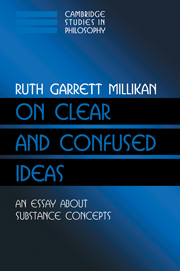Book contents
- Frontmatter
- Contents
- Preface
- Chapter 1 Introducing Substance Concepts
- Chapter 2 Substances: The Ontology
- Chapter 3 Classifying, Identifying, and the Function of Substance Concepts
- Chapter 4 The Nature of Abilities: How Is Extension Determined?
- Chapter 5 More Mama, More Milk and More Mouse: The Structure and Development of Substance Concepts
- Chapter 6 Substance Concepts Through Language: Knowing the Meanings of Words
- Chapter 7 How We Make Our Ideas Clear: Epistemology for Empirical Concepts
- Chapter 8 Content and Vehicle in Perception
- Chapter 9 Sames Versus Sameness in Conceptual Contents and Vehicles
- Chapter 10 Grasping Sameness
- Chapter 11 In Search of Strawsonian Modes of Presentation
- Chapter 12 Rejecting Identity Judgments and Fregean Modes
- Chapter 13 Knowing What I'm Thinking Of
- Chapter 14 How Extensions of New Substance Concepts are Fixed: How Substance Concepts Acquire Intentionality
- Chapter 15 Cognitive Luck: Substance Concepts in an Evolutionary Frame
- Appendix A Contrast with Evans on Information-Based Thoughts
- Appendix B What Has Natural Information to Do with Intentional Representation?
- References
- Index
Chapter 8 - Content and Vehicle in Perception
Published online by Cambridge University Press: 02 December 2009
- Frontmatter
- Contents
- Preface
- Chapter 1 Introducing Substance Concepts
- Chapter 2 Substances: The Ontology
- Chapter 3 Classifying, Identifying, and the Function of Substance Concepts
- Chapter 4 The Nature of Abilities: How Is Extension Determined?
- Chapter 5 More Mama, More Milk and More Mouse: The Structure and Development of Substance Concepts
- Chapter 6 Substance Concepts Through Language: Knowing the Meanings of Words
- Chapter 7 How We Make Our Ideas Clear: Epistemology for Empirical Concepts
- Chapter 8 Content and Vehicle in Perception
- Chapter 9 Sames Versus Sameness in Conceptual Contents and Vehicles
- Chapter 10 Grasping Sameness
- Chapter 11 In Search of Strawsonian Modes of Presentation
- Chapter 12 Rejecting Identity Judgments and Fregean Modes
- Chapter 13 Knowing What I'm Thinking Of
- Chapter 14 How Extensions of New Substance Concepts are Fixed: How Substance Concepts Acquire Intentionality
- Chapter 15 Cognitive Luck: Substance Concepts in an Evolutionary Frame
- Appendix A Contrast with Evans on Information-Based Thoughts
- Appendix B What Has Natural Information to Do with Intentional Representation?
- References
- Index
Summary
INTRODUCTION
I have tried to show that the ability to reidentify things that are objectively the same when we encounter them in perception is the most central cognitive ability that we possess. It is an extremely difficult task, deserving careful study by psychologists and neuroscientists as well philosophers. But in order to study how a task is performed one must begin, of course, with some understanding of what that task is. We have not yet asked in what the act of reidentifying consists.
The question is made more difficult by a tradition we have all been trained in, philosophers and psychologists alike, that takes the answer to be obvious. Answers to various other questions have then been constructed on this implicit foundation, so that challenges to it have become both hard to understand and anxiety producing. This traditional answer is that reidentifying an object or property in either perception or thought consists in being able to discriminate it, and that this ability is manifested in sameness of one's reaction to the object, or sameness of one's treatment of it, or sameness of the mental term or concept one applies to it. That is, reidentifying is repeating some kind of response. Call this “the repetition view of reidentifying.”
One familiar doctrine constructed on the repetition view is that when sameness in the referential content of two perceptions or thoughts fails to be transparent to the thinker, this is because the content is not thought of in the same way both times.
- Type
- Chapter
- Information
- On Clear and Confused IdeasAn Essay about Substance Concepts, pp. 109 - 122Publisher: Cambridge University PressPrint publication year: 2000



